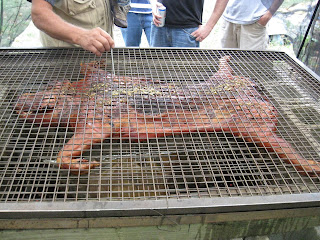Recently I became the caretaker of a cute little plasma cutter. I have been wanting one of these for some time and was excited to foster its care while its owner re-arranged his shop situation. I immediately hooked it up and started playing around, cutting steel letters with very poor results. Knowing from research that this was not what I should expect, I began to delve into the "whys". Not unlike my miserable success with
spraying finishes, much had to do with lack of any experience, so I expect that perseverance will eventually pay.
Upon talking to the plasma cutter's owner, I learned that the consumables are probably in need of replacement, so I undertook acquiring those supplies. Additionally, he said that the compressed air feed must be very dry. Hmmm. I have no dryer on my air lines. I thought this may also be part of my spray finishing problem. And, the plasma cutter had a little brother--a media blaster--that I was also housing. He, too, would need very dry air. So, I went about looking into air drying. Lots of methods, products, and opinions on that one, trust me. Purchasing drying equipment was way out of the budget (budget always starts at $0 and eventually piles up to more money in parts to build a solution than the total cost to buy a solution--but where is the fun in that?).
So I fired up my sputnik and launched into the Blogosphere. I am constantly amazed at how many people have the same problems and ideas that I have, but have already tried and failed or succeeded, then blogged about it. What a great tool, this internet--thank you Al Gore.
After reading many ideas about drying air, I decided that the cooling approach (cool air won't hold water) makes the most sense, since that is how it is done industrially. In many posts, a design referred to as the "Franzinator", named for an internet curmudgeon called Franz, was lauded as the best low cost solution. So I decided to build one. Although I cannot take credit for the concept, the means and methods are mine and I think my approach is reasonably blog-able.

Two dimensions stuck out as critical to this concept: the pipe must be 2" diameter and 36" long. The air must enter the vessel in the middle. In essence, this is an inter-cooler. Air is piped with 3/4" copper from the compressor head into the middle of the vessel and out the top of the vessel and then into the storage tank. Steel pipe is preferred for the vessel since it transfers heat through convection better than copper. Plus, copper pipe and fittings this size would cost a fortune. Of course this size steel pipe and fittings aren't exactly Lowe's items either. Enter your neighborhood fire suppression contractor. Fortunately, I do business with just such a guy. He supplied me with (2) 17" x 2" threaded pipes, a 2" x 1" T, and (2) 2" x 1" reducers.
The critical part in this mess is inside the vessel. As the air comes from the compressor in 3/4" copper, it enters into the middle of the vessel through the T and then makes a 90 degree bend downward. The outlet from the copper line into the vessel is a reduced orifice +/- 1/4". This increases the pressure and flash cools the air while directing it towards the bottom of the vessel, where it then redirects upward towards the exit at the top through a 3/4" copper line and into the storage tank. This process significantly cools the air and causes it to lose most of its water inside the vessel, where it condenses on the inside walls of the pipe and runs down to the bottom, where there is a boiler drain. This also intercepts much of the oil from the compressor.

I made the transition from copper to steel with a simple threaded copper fitting. I reduced the 3/4" line to 1/2" with a bushing inside a 3/4" coupling, then put the threaded fitting on the coupling. This gave me a 1/2" copper pipe inside the 3/4 pipe protruding past the threaded coupling into the steel T. Inside the T, I sweat a 90 then the closed end of a fixture stub (used in new construction at the point where a fixture will be connected so that an air test can be done without a valve). I chucked the fixture stub into my lathe and bored a 1/4 hole, making the orifice. With this basic "metering device" sweat in place, I simply threaded the bottom pipe into the T and had the unit ready to go.


I mounted some uni-strut to the compressor and used fence post brackets to connect the vessel to the uni-strut. The whole thing was too flimsy and I hoped that connecting the copper lines would stiffen it up. Once connected, the system was much more stable, but still not enough for the vibration of the compressor, so I am resigned to bracing it back to the wall with some all-thread stand-offs. On the first run test, I must say I was a little nervous about the pipe-bomb that I had created. But I reasoned that 100 psi is not that much and all of the materials are routinely tested to much higher pressures. I soap sprayed all my fittings and everything is air tight (amazingly). I had often wondered if the cooling fins on the air line between the two compressor heads actually did any good. The answer was evident when I put my hand on the new air line without fins running from the head to the vessel--burned me. In phase two, I will take heat measurements, but for now, I can say that I cannot touch the pre-cooler line, and I can grab and hold the post cooler line.

I am super excited about this weekend, because I am going to finish this baby up with the coup des grace: an after cooler! First, I have saved some empty beer and soda cans that will become cooling fins on the incoming air line. Second, I am installing a 1/4" copper coil around the vessel and circulating water through an old drinking fountain (job scrap) with a recently liberated condensate pump. More on that later.


















































